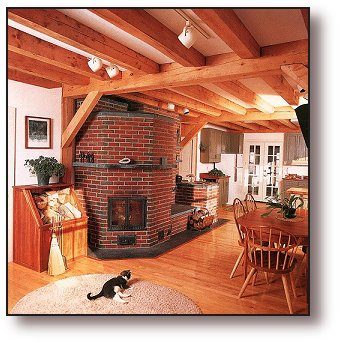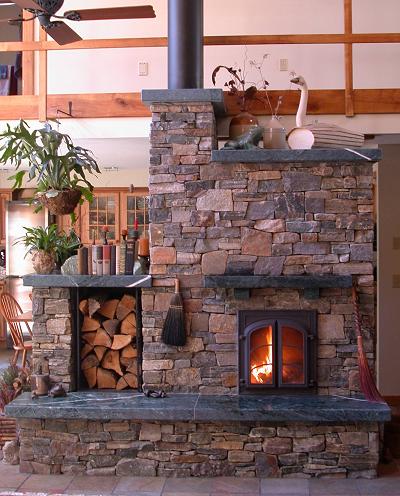Masonry Heater
A masonry heater warms space by storing the heat from occasional intense fires and gently releasing it into the space over a longer period of time. These have been used in various forms, right back to the early Roman hypocausts in which the smoke and flue gasses from a fire was passed under a floor raised on tile stacks.
Modern designs are based around a firebox core with heat exchange ducts or baffles constructed on a sturdy plinth to support the weight. A masonry shell is built around the ducting to form the thermal mass.
Masonry stoves may take 24 to 48 hours to reach full heat which makes them well suited for long term heating when compared to smaller metal stoves which supply rapid bursts of intense heat when lit. They are a good option if you are planning to provide the bulk of your home heating with wood fuel.
Masonry Stove Key Features
- Efficient use of wood fuel
- Whole home heating solution (when carefully designed into a home)
- Exterior can be designed and extensively customised
- The stove can be made into a bench, structural support for upper stories, stairways etc...
- They can include bake ovens for cooking
- They come in kit form and can be assembled on site
- It is difficult to fit one into an existing fireplace, much easier to design one into a new home
- One stove can heat multiple rooms and stories if built into the fabric of a building.
How to get one?
DIY from Plans
If you have a highly skilled bricklayer you can probably make use of DIY plans for a masonry stove. They are quite technical, due to the complexities of making brick runs that can cope with the variable heat loads through the brick work without cracking.
Most DIY Masonry stoves these days are based around a pre-cast heat core, made of specialised high temperature refractory ceramics. This is vital to ensure long term durability of the core, to save major disruption and expensive maintenance in future years.

Have a stove designed and built by a Masonry Stove Builder
The Masonry Stove Builders Association has done much to promote the wider acceptance of masonry stoves in the USA, and the technical expertise of it's members is excellent.
They have excellent galleries of stoves installed across the USA, as well as a directory of installers.
Cost implications
Typically a masonry stove will cost double to triple that of a simple metal stove installation. For many this cost is prohibitive, but the high thermal mass of these stoves has many advantages - lower fuel use, easier management, more balanced temperatures throughout the day etc...
Over the past few years the cost has been coming down, however, through the use of standard pre-fab heat cores and a simple customised brickwork skin.


